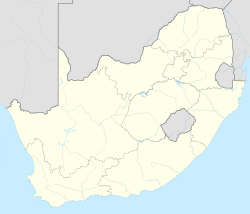Peddie iNgqushwa | |
|---|---|
 | |
| Coordinates: 33°11′46″S27°06′58″E / 33.196°S 27.116°E | |
| Country | South Africa |
| Province | Eastern Cape |
| District | Amathole |
| Municipality | Ngqushwa |
| Area | |
• Total | 37.32 km2 (14.41 sq mi) |
| Population (2011) [1] | |
• Total | 4,658 |
| • Density | 120/km2 (320/sq mi) |
| Racial makeup (2011) | |
| • Black African | 98.2% |
| • Coloured | 1.4% |
| • Indian/Asian | 0.1% |
| • White | 0.2% |
| • Other | 0.2% |
| First languages (2011) | |
| • Xhosa | 86.4% |
| • English | 7.5% |
| • Afrikaans | 1.5% |
| • Other | 4.6% |
| Time zone | UTC+2 (SAST) |
| Postal code (street) | 5640 |
| PO box | 5640 |
| Area code | 040 |
Peddie (Xhosa: iNgqushwa) is a town in the Ngqushwa Local Municipality [2] within the Amathole District Municipality in the Eastern Cape province of South Africa.



